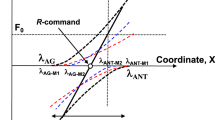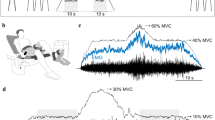Abstract.
An experiment was performed to characterise the movement kinematics and the electromyogram (EMG) during rhythmic voluntary flexion and extension of the wrist against different compliant (elastic-viscous-inertial) loads. Three levels of each type of load, and an unloaded condition, were employed. The movements were paced at a frequency of 1 Hz by an auditory metronome, and visual feedback of wrist displacement in relation to a target amplitude of 100° was provided. Electromyographic recordings were obtained from flexor carpi radialis (FCR) and extensor carpi radialis brevis (ECR). The movement profiles generated in the ten experimental conditions were indistinguishable, indicating that the CNS was able to compensate completely for the imposed changes in the task dynamics. When the level of viscous load was elevated, this compensation took the form of an increase in the rate of initial rise of the flexor and the extensor EMG burst. In response to increases in inertial load, the flexor and extensor EMG bursts commenced and terminated earlier in the movement cycle, and tended to be of greater duration. When the movements were performed in opposition to an elastic load, both the onset and offset of EMG activity occurred later than in the unloaded condition. There was also a net reduction in extensor burst duration with increases in elastic load, and an increase in the rate of initial rise of the extensor burst. Less pronounced alterations in the rate of initial rise of the flexor EMG burst were also observed. In all instances, increases in the magnitude of the external load led to elevations in the overall level of muscle activation. These data reveal that the elements of the central command that are modified in response to the imposition of a compliant load are contingent, not only upon the magnitude, but also upon the character of the load.
Similar content being viewed by others
Author information
Authors and Affiliations
Additional information
Electronic Publication
Rights and permissions
About this article
Cite this article
Mackey, .D., Meichenbaum, .D., Shemmell, .J. et al. Neural compensation for compliant loads during rhythmic movement. Exp Brain Res 142, 409–417 (2002). https://doi.org/10.1007/s00221-001-0946-z
Received:
Accepted:
Issue Date:
DOI: https://doi.org/10.1007/s00221-001-0946-z




